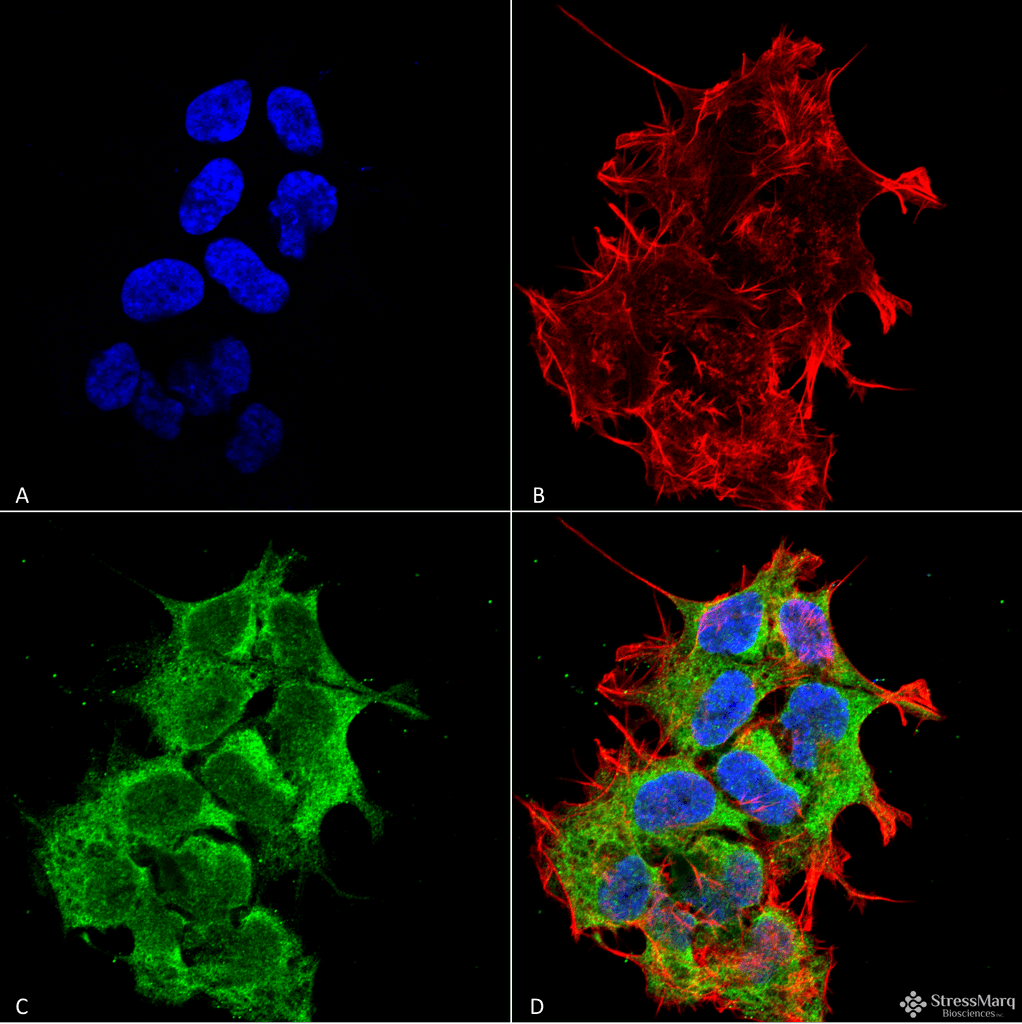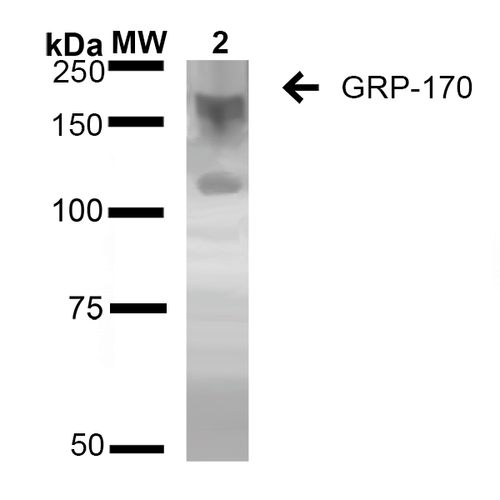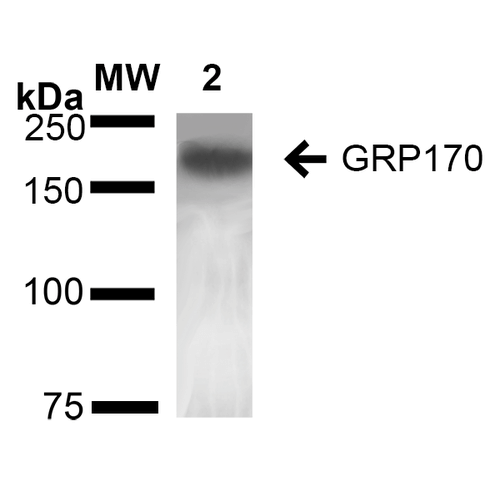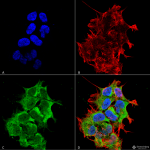Properties
| Storage Buffer | PBS pH7.4, 50% glycerol, 0.1% sodium azide *Storage buffer may change when conjugated |
| Storage Temperature | -20ºC, Conjugated antibodies should be stored according to the product label |
| Shipping Temperature | Blue Ice or 4ºC |
| Purification | Protein G Purified |
| Clonality | Monoclonal |
| Clone Number | 6E3-2C3 |
| Isotype | IgG2b |
| Specificity | Detects ~170kDa. |
| Cite This Product | StressMarq Biosciences Cat# SMC-232, RRID: AB_2699466 |
| Certificate of Analysis | 1 µg/ml of SMC-232 was sufficient for detection of GRP170 in 20 µg of HEK293 lysate by colorimetric immunoblot analysis using Goat anti-mouse IgG:HRP as the secondary antibody. |
Biological Description
| Alternative Names | ORP150 Antibody, HSP12A Antibody, Hypoxia up regulated 1 Antibody, Orp150 Antibody, Glucose regulated Antibody 170 Antibody, 150kDa oxygen regulated Antibody Antibody, 150 kDa oxygen regulated protein antibody, 150 kDa oxygen-regulated protein antibody, 170 kDa glucose regulated protein antibody, 170 kDa glucose-regulated protein antibody, DKFZp686N08236 antibody, FLJ94899 antibody, FLJ97572 antibody, glucose regulated protein 170 antibody, Grp 170 antibody, GRP-170 antibody, Grp170 antibody, HSP 12A antibody, HSP12A antibody, Hyou1 antibody, HYOU1_HUMAN antibody, Hypoxia up regulated 1 antibody, hypoxia up-regulated 1 precursor antibody, Hypoxia up-regulated protein 1 antibody, Hypoxia upregulated 1 antibody, Orp 150 antibody, ORP-150 antibody, Orp150 antibody, oxygen regulated protein (150kD) antibody |
| Research Areas | Cancer, Cancer Metabolism, Cardiovascular System, Cell Signaling, Chaperone Proteins, Epigenetics and Nuclear Signaling, ER Proteins, Heat Shock, Hypoxia, Invasion/microenvironment, Metabolism, Metabolism processes, Neurodegeneration, Neuroscience, Protein Trafficking, Response to Hypoxia |
| Cellular Localization | Endoplasmic Reticulum, Endoplasmic reticulum lumen |
| Accession Number | NP_006389.3 |
| Gene ID | 10525 |
| Swiss Prot | Q9Y4L1 |
| Scientific Background | GRP170, also known as ORP150, is the largest member of glucose-regulated Antibodys, and acts as a human chaperone Antibody. It is thought to play an important role in Antibody folding and secretion in the ER. Suppression of the Antibody is associated with accelerated apoptosis, therefore having an important cryoprotective role in hypoxia-induced cellular pertubation. This cryopotective role has led to an anti-tumor immune response, which will hopefully lead to therapeutic immunizations against cancers (1). GRP170 has also been shown to bind with dendritic cells and provide the danger signals to induce anti-tumor immune responses (2). |
| References |
1. Wang H., et al. (2014) Front Oncol. 4: 377. 2. Manjili M.H., et al. (2006) Immun. Cell Biol. 84: 203-208. |
Product Images

Immunocytochemistry/Immunofluorescence analysis using Mouse Anti-GRP170 Monoclonal Antibody, Clone 6E3-2C3 (SMC-232). Tissue: Neuroblastoma cell line (SK-N-BE). Species: Human. Fixation: 4% Formaldehyde for 15 min at RT. Primary Antibody: Mouse Anti-GRP170 Monoclonal Antibody (SMC-232) at 1:100 for 60 min at RT. Secondary Antibody: Goat Anti-Mouse ATTO 488 at 1:100 for 60 min at RT. Counterstain: Phalloidin Texas Red F-Actin stain; DAPI (blue) nuclear stain at 1:1000; 1:5000 for 60 min RT, 5 min RT. Localization: Endoplasmic Reticulum, Endoplasmic Reticulum Lumen. Magnification: 60X. (A) DAPI (blue) nuclear stain. (B) Phalloidin Texas Red F-Actin stain. (C) GRP170 Antibody. (D) Composite.

Western Blot analysis of Human Embryonic kidney epithelial cell line (HEK293) lysates showing detection of ~170 kDa GRP170 protein using Mouse Anti-GRP170 Monoclonal Antibody, Clone 6E3-2C2 (SMC-232). Lane 1: Molecular Weight Ladder (MW). Lane 2: HEK-293 cell lysate. Load: 20 µg. Block: 2% BSA and 2% Skim Milk in 1X TBST. Primary Antibody: Mouse Anti-GRP170 Monoclonal Antibody (SMC-232) at 1:1000 for 16 hours at 4°C. Secondary Antibody: Goat Anti-Mouse IgG: HRP at 1:100 for 60 min at RT. Color Development: ECL solution for 6 min in RT. Predicted/Observed Size: ~170 kDa. Other Band(s): 100 kDa.

Western Blot analysis of Rat Liver showing detection of ~170 kDa GRP170 protein using Mouse Anti-GRP170 Monoclonal Antibody, Clone 6E3-2C3 (SMC-232). Lane 1: Molecular Weight Ladder (MW). Lane 2: Rat Liver cell lysate. Load: 20 µg. Block: 2% BSA and 2% Skim Milk in 1X TBST. Primary Antibody: Mouse Anti-GRP170 Monoclonal Antibody (SMC-232) at 1:1000 for 16 hours at 4°C. Secondary Antibody: Goat Anti-Mouse IgG: HRP at 1:100 for 60 min at RT. Color Development: ECL solution for 6 min in RT. Predicted/Observed Size: ~170 kDa.


![Mouse Anti-GRP170 Antibody [6E3-2C2] used in Western Blot (WB) on Human Embryonic kidney epithelial cell line (HEK293) lysates (SMC-232)](https://www.stressmarq.com/wp-content/uploads/SMC-232-GRP170-Antibody-6E3-2C2-WB-Human-HEK-293-cell-lysate-1-100x100.png)
![Mouse Anti-GRP170 Antibody [6E3-2C3] used in Western Blot (WB) on Rat Liver (SMC-232)](https://www.stressmarq.com/wp-content/uploads/SMC-232-GRP170-Antibody-6E3-2C3-WB-Rat-Liver-1-100x100.png)




















Reviews
There are no reviews yet.